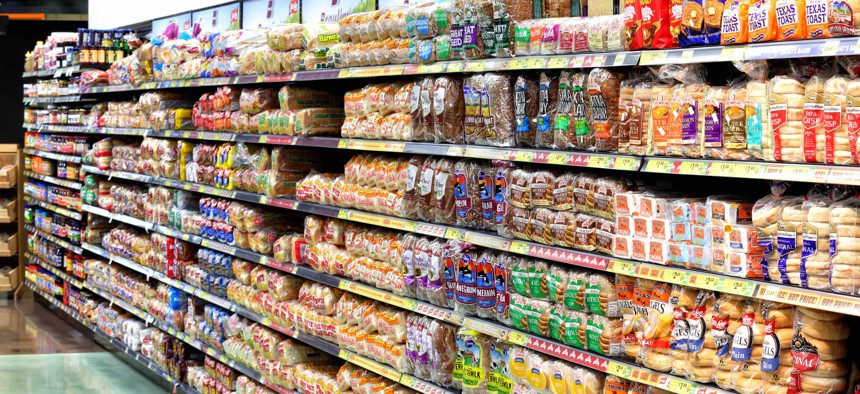Food Stamps Fall Short of Meal Costs in Most Counties, Study Finds

A grocery store interior in Idaho Falls, Idaho, during June of 2016. shutterstock
The findings come at a time when the Trump administration has proposed lower spending on the program in the coming years.
Food stamp benefits, even for people with no net income, are not enough to cover the full cost of an inexpensive meal in most U.S. counties, according to a study released on Thursday.
Benefits through what’s known as the as the Supplemental Nutrition Assistance Program, or SNAP, fell short of the cost for a “low-income meal” in 99 percent of counties in the continental U.S. and the District of Columbia, during 2015, an Urban Institute analysis found.
The average cost of a low-income meal, which is defined as part of the study, was $2.36. That cost is 27 percent higher than the maximum SNAP benefit per meal of $1.86. Over the course of a month, benefits were shy of average meal costs by $46.50 per person.
SNAP benefits are typically not expected to cover the full cost of a household food budget, except in situations where a household has no net income, the authors of the study explain. Citing federal figures, they note that about 37 percent of SNAP recipients had zero net income in fiscal year 2016, after claiming eligible income deductions.
“For the nearly 4 in 10 households that have zero net income, the maximum SNAP benefit is the only way for families to pay for the meals they need to receive minimum levels of nutrition and reduce food insecurity,” the researchers point out in their report.
The findings come at a time when the Trump administration, in its fiscal 2019 budget released last week, proposed reducing spending on SNAP by about $213 billion over the next decade. Congress would need to go along with the president's spending plans for them to be enacted.
At the federal level, the U.S. Department of Agriculture’s Food and Nutrition Service oversees SNAP. “USDA will review this study and take into consideration any recommendations,” an agency spokesperson said by email on Wednesday, referring to the Urban Institute report.
The researchers also looked at how meal costs varied between counties, and found that the biggest gaps between SNAP benefits and food prices were in high-cost urban areas, like New York City and San Francisco, and smaller rural counties—some with tourist attractions.
“Better aligning the maximum SNAP benefit with county-level meal costs is one key component of a broader strategy for ensuring that SNAP achieves its mission to reduce hunger and food insecurity and the associated negative health outcomes,” the report says.
(An interactive map and database showing the gap between benefits and meal costs for individual counties can be found here.)
SNAP is the nation’s main federal food assistance program, with about 42 million participants and benefits that totaled nearly $64 billion in fiscal 2017. It is funded largely by the federal government, but run by states. The cost of SNAP benefits in fiscal 2017 was equal to about 1.6 percent of the roughly $4 trillion federal budget for that budget cycle.
The number of people using the program climbed steeply in the wake of the Great Recession and has not fully receded since.
In 2007, the number of monthly SNAP participants averaged around 26 million. But, since 2010, the figure has been between 40 million and 48 million, although it has been declining in recent years, with caseloads falling by about 2 million last year.
To be eligible for food stamps, a household must meet certain income requirements. Household income can typically not exceed 130 percent of the federal poverty level. This income eligibility threshold for the program was about $26,600 annually, for a family of three, in 2018.
Benefits are based on factors including income and the number of people in a household.
Most adults who are not disabled, are younger than 50 years old, and who do not have children, are restricted to three months of benefits in three years, unless they meet certain work requirements or are enrolled in qualifying education or training programs.
An average SNAP recipient received about $126 per month in fiscal 2017, according to The Center on Budget and Policy Priorities.
One change to SNAP that President Trump proposes in his latest budget plan is for households receiving $90 or more per month in benefits to receive a portion of those benefits in the form of a food package, with items like cereal, pasta, peanut butter and canned goods.
White House budget director, Mick Mulvaney, likened the proposal to food delivery services like Blue Apron. “It lowers the cost to us because we can buy prices at wholesale,” he said last week.
The authors of the newly released study on SNAP include Elaine Waxman and Megan Thompson, of the Urban Institute, and Craig Gundersen, a professor in the department of agricultural and consumer economics at the University of Illinois.
A full copy can be found here.
Bill Lucia is a Senior Reporter for Government Executive’s Route Fifty and is based in Washington, D.C.
NEXT STORY: State Officials Want More Election Security Intel From Feds






